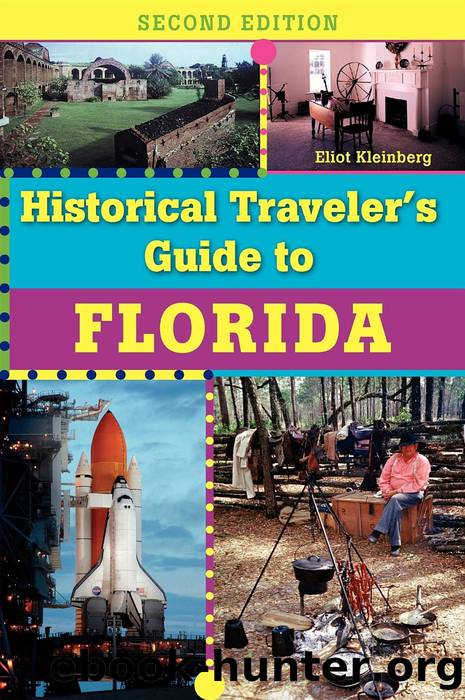Historical Traveler's Guide to Florida by Eliot Kleinberg

Author:Eliot Kleinberg
Language: eng
Format: epub
Publisher: Pineapple Press
Published: 2015-06-14T16:00:00+00:00
Read More About It
Mormino, Gary R., and George E. Pozzetta. The Immigrant World of Ybor City: Italians and Their Latin Neighbors in Tampa, 1885–1985. 1987, Champaign, Ill., University of Illinois Press.
Pacheco, Ferdie. Ybor City Chronicles: A Memoir. 1994, Gainesville, University Press of Florida.
Pizzo, Tony. Tampa Town: The Cracker Village with a Latin Accent. 1968, Coconut Grove, Hurricane Press.
Turton, Peter. José Martí. 1986, London, Zed.
De Soto National Memorial
Bradenton
Did de Soto land here?
The problem with the De Soto National Memorial: everyone agrees Hernando de Soto came to Florida — but not necessarily that he came there. The federal historic site and park sits on a spit of land providing a majestic view of the mouth of giant Tampa Bay. It’s a monument to the historic moment when the Spanish explorer came ashore on May 30, 1539, and started his four-year trek across the continent. But some argue the actual landfall was at Charlotte Harbor, about 100 miles south, or the Little Manatee River, a little to the north.
At the De Soto Memorial, you will find a gathering of thatch huts, a visitors center, and walkways with bayfront plaques describing the expedition. From late December to early April, park rangers dressed in period costume portray life as it may have been in De Soto’s base camp. Their special programs include demonstrations of sixteenth-century Spanish weapons.
A nature trail follows a half-mile loop through mangroves and beach. A visitors center displays samples of period armor and weapons. Other materials show the culture of the natives who inhabited Florida before the Europeans but were extinct within two centuries of their arrival.
Earlier, in 1513, Juan Ponce de León had planted the cross and the flag of Spain on Florida’s east coast. Spain hadn’t a clue of how far La Florida went, so the king sent De Soto to inspect the property. The explorer, only 39, was already wealthy from having helped plunder Peru and hoped for more loot in this terra incognita, this dark continent to the north:
“Some old men of authority … say that … two days journey beyond is another town called Ocale … that there are many traders among them … and abundance of gold and silver and many pearls; … Glory be to God … it seems He has a special care that this be for His service,” De Soto wrote.
“Black Legend”
Some people were already inhabiting North America, but no matter. Europeans considered them savages. The “black legend” of Spanish atrocities in the Americas includes De Soto’s first encounters with Indians, many of whom he slaughtered or enslaved.
De Soto began his mission with more than 600 men and 223 horses, pigs, and dogs. Indians were enslaved and brought along; the number grew at times to more than 1,000. The group first wintered at a site near Florida’s present capital, Tallahassee. There, they probably spent North America’s first Christmas before continuing inland, heading through the southern interior of the continent. The expedition wandered through what is now Arkansas; on June 20, 1542, De Soto was felled by a fever and a broken heart.
Download
This site does not store any files on its server. We only index and link to content provided by other sites. Please contact the content providers to delete copyright contents if any and email us, we'll remove relevant links or contents immediately.
Moon Great Smoky Mountains National Park by Jason Frye(627)
Stede Bonnet by Christopher Byrd Downey(581)
Lonely Planet Washington, DC by Lonely Planet(557)
A Taste of Coral Gables by Paola Mendez(548)
In the Land of Good Living by Kent Russell(546)
Birds of Florida by Todd Telander(535)
Birnbaum's 2020 Walt Disney World: The Official Vacation Guide by Birnbaum Guides & Birnbaum Guides(534)
Miami Noir by Les Standiford(529)
Fodor's Walt Disney World with Kids 2013 by Kim Wright Wiley(500)
Fodor's South Florida by Fodor's Travel Guides(492)
Paddling Everglades and Biscayne National Parks by Roger L. Hammer(489)
Mansfield Plantation by Christopher Boyle(479)
Robicelli's by Allison Robicelli(478)
Unofficial Guide to Walt Disney World with Kids 2019 by Bob Sehlinger(473)
I Do... Destination Florida: No Passport Required by Buckley Beth Benton(469)
Fodor's Washington, D.C. 2016 by Fodor's(468)
DK Eyewitness Washington, DC by DK Eyewitness(461)
Unofficial Guide to Washington, D.C. by Renee Sklarew(460)
Paddling the Everglades Wilderness Waterway by Holly Genzen(458)
